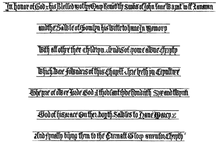John Lane (clothier)
John Lane (died 1528) was a wealthy clothier from Cullompton in Devon, remembered today for having built the magnificent Lane Chapel (or Lane Aisle) on the south side of St Andrew's Church, Cullompton. Due to a misreading of the inscription on the exterior of his Chapel he was said by Polwhele (1793) to have occupied the office of Wapentake Custos,[1] Lanarius,[2][3] (translated as "Constable of the Hundred, wool merchant"). However no historical evidence supports the existence of such an office and the inscription was later correctly re-interpreted by Smirke (1847).[4]
Lane Chapel
The Lane Chapel is a grand structure of five bays with large windows[5] and a magnificent fan-vaulted ceiling. Building work commenced in 1526 (as is stated on the lengthy inscription on the external walls), two years before Lane's death, was continued by his widow Thomasine and finished in 1552, according to an inscription on the exterior of the east wall.[6] It is profusely embellished in the interior on the ceiling corbels and bosses with relief sculptures of angels holding Lane's merchant's mark. The exterior walls are embellished with relief sculptures (now severely worn away by the elements) of biblical scenes and of items related to Lane and his trade,[7] such as ships, cloth shears, teasel frames, merchant's marks, monograms, etc. A lengthy relief-sculpted inscription in English in black-letter Gothic script runs around the three exterior walls of the building, low-down beneath the windows (see below).
The Lane Chapel is comparable in many respects to the nearby Greenway Chapel and Greenway Porch in St Peter's Church, Tiverton, built in 1517[8] by his contemporary fellow merchant John Greenway (died 1529).
Dispute with Moore family
At the east end of the opposite (north) aisle of Cullompton Church is situated the Moor Hayes Chapel, anciently the property of the Moore family of Moor Hayes, within the parish, lords of the manor of Cullompton. Lane's widow had a dispute with this family concerning their trespassing into the Lane Chapel, which resulted in a law suit heard by the Star Chamber, the record of which is held at the National Archives at Kew, summarised as follows:[9]
- "Plaintiff: Thomasyne late wife of John Lane, of Cullompton; Defendant: Humphrey More, John More, Christopher More, and John Smyth. Place or subject: Forcible entry into a chapel built by plaintiff's late husband adjoining to the parish church".
Ledger stone
He was buried at the east end of his Chapel, where survives his ledgerstone, in the middle of the aisle and now mostly covered by box-pews and missing the monumental brasses of which only the matrices remain, in the shapes of a man and a woman, wearing a headdress, facing each other, the man on the left and his wife on the right, with two lozenge-shaped heraldic shields above, also missing their brasses. The heads of the figures face the west-end of the Chapel. The ledger line is inscribed in Latin as follows:[10]
- Hic jacet Joh(anne)s Lane, M(er)cator, huiusq(ue) capellae fundator cum Thomasi(n)a uxore sua, qui dict(us) Johan(nes) obi(i)t XV. Feb(ruarii) annoque Dom(ini) mill(ensim)o CCCCCXXVIII.[11] ("Here lies John Lane, merchant, founder of this chapel, with Thomasine his wife, which said John died on the 15th (day) of February in the year of our Lord the one thousandth five hundredth and twenty eighth").
External inscription


The following inscription, in parts much worn-away by the elements, is sculpted low-down on the outside wall of the aisle, running round all three sides of the building, with each word cut on detached stones:[13]
- "In honor of God and his blessed Mother Mary, remember the soule of John Lane (with a Pater Noster and Ave Mary)[14](Wapentake Custos,[15] Lanarius,[16])[17] and the soule of Thomasine his wife, to have in memory all other their children and friends of your own charity which were founders of this chapple, and here lie in sepulture, the year of our Lord one thousand five hundred and six and twenty. God of his grace on both their soules to have mercy, and finally bring them to eternal glory. Amen for charity."
Further reading
- Carus-Wilson, Eleanora (1957), "The Significance of the Secular Sculpture in the Lane Chapel, Cullompton" (PDF), Medieval Archaeology, 1: 104–17 and end plates, doi:10.1080/00766097.1957.11735385

References
- Custos (Latin), "custodian", thus Constable of the hundred (of Collumpton?)
- Lanarius (Latin), "wool merchant"
- Polwhele, Richard, History of Devonshire, 3 Vols., Vol.2, London, 1793, p.255)
- Smirke, Edward, Notice on Some Obscure Words in the Inscription on the Lane Chantry at Columpton, Transactions of the Exeter Diocesan Architectural Society, Volume 3, Exeter Diocesan Architectural and Archaeological Society, Exeter, 1846-9, pp.62-5
- Cooke
- Cooke
- Cooke
- Pevsner, Nikolaus & Cherry, Bridget, The Buildings of England: Devon, London, 2004, p.808
- National Archives at Kew: STAC - Records of the Court of Star Chamber and of other courts, ref: STAC 2/25/142, Date: 22/04/1509-28/01/1547
- Cooke, George Alexander, Topography of Great Britain, 1802-29Cooke, George Alexander, Topography of Great Britain, 1802-29; Also transcribed less accurately in Westcote, Thomas, A View of Devonshire in 1630 with a Pedigree of most of its Gentry, Exeter, 1845, p.115
- Cooke, with date of death corrected to 1528 from 1527, as is apparent from the ledger stone
- Delagarde, Philip Chilwell, An Account of the Church of St Andrew, Cullompton, published in Transactions of the Exeter Diocesan Architectural Society, Volume 3, Exeter, 1846-9, p.57
- Transcribed by Cooke
- reinterpretation of Polwhele's transcript ("Wapentake Custos Lanarius") by Smirke, Edward, Notice on Some Obscure Words in the Inscription on the Lane Chantry at Columpton, Transactions of the Exeter Diocesan Architectural Society, Volume 3, Exeter Diocesan Architectural and Archaeological Society, Exeter, 1846-9, pp.62-5
- Custos (Latin), "custodian", thus Constable of the hundred (of Collumpton?)
- Lanarius (Latin), "wool merchant"
- Polwhele's interpretation (Polwhele, Richard, History of Devonshire, 3 Vols., Vol.2, London, 1793, p.255)